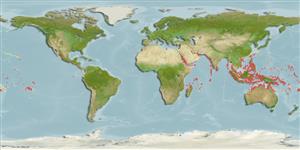>
Gobiiformes (Gobies) >
Microdesmidae (Wormfishes) > Ptereleotrinae
Etymology: Parioglossus: Greek, pareia = jaw + Greek, glossa = tongue (Ref. 45335).
Eponymy: Professor Dr H Srinivasa Rao (1894–1971) was an Indian zoologist who specialised in faunistic morphology. [...] (Ref. 128868), visit book page.
More on author: Herre.
Environment: milieu / climate zone / depth range / distribution range
Sinh thái học
Biển; Thuộc về nước lợ Cùng sống ở rạn san hô. Tropical; 30°N - 20°S
Indo-West Pacific: Arabian Gulf and the Gulf of Oman (Ref. 11441) to Fiji, north to the Ryukyu Islands, south to Indonesia. Recently recorded from Tonga (Ref. 53797).
Bộ gần gũi / Khối lượng (Trọng lượng) / Age
Maturity: Lm ? range ? - ? cm
Max length : 3.5 cm SL con đực/không giới tính; (Ref. 48637)
Các tia vây lưng cứng (tổng cộng) : 7; Các vây lưng mềm (tổng cộng) : 14 - 16; Tia cứng vây hậu môn: 1; Tia mềm vây hậu môn: 14 - 16. Body yellowish brown with a black longitudinal stripe and a bright blue spot between dorsal spines 5 and 6. SL to 25 mm (Ref. 1602).
Inhabits mangrove swamps and inlet waters (Ref. 559); shallow coastal waters with mud, sand, or rock bottoms (Ref. 1602). Forms aggregations near surface (Ref. 90102).
Life cycle and mating behavior
Chín muồi sinh dục | Sự tái sinh sản | Đẻ trứng | Các trứng | Sự sinh sản | Ấu trùng
Masuda, H., K. Amaoka, C. Araga, T. Uyeno and T. Yoshino, 1984. The fishes of the Japanese Archipelago. Vol. 1. Tokai University Press, Tokyo, Japan. 437 p. (text). (Ref. 559)
IUCN Red List Status (Ref. 130435: Version 2024-2)
Threat to humans
Harmless
Human uses
Các công cụ
Special reports
Download XML
Các nguồn internet
Estimates based on models
Preferred temperature (Ref.
123201): 26.4 - 29.3, mean 28.5 °C (based on 3075 cells).
Phylogenetic diversity index (Ref.
82804): PD
50 = 0.5000 [Uniqueness, from 0.5 = low to 2.0 = high].
Bayesian length-weight: a=0.00389 (0.00180 - 0.00842), b=3.12 (2.94 - 3.30), in cm total length, based on all LWR estimates for this body shape (Ref.
93245).
Mức dinh dưỡng (Ref.
69278): 3.2 ±0.4 se; based on size and trophs of closest relatives
Fishing Vulnerability (Ref.
59153): Low vulnerability (10 of 100).
